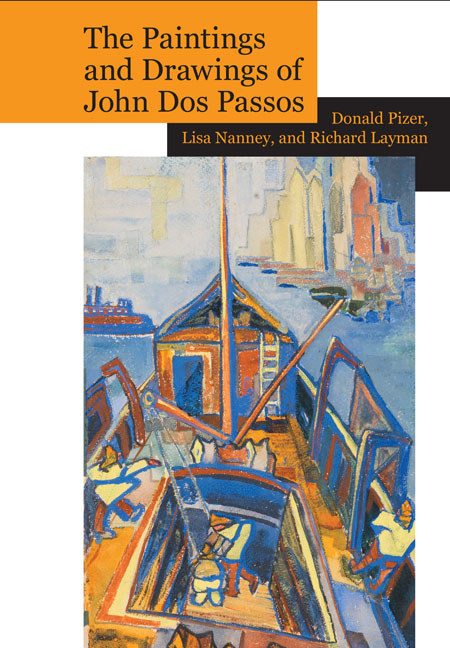Book contents
- Frontmatter
- Contents
- Preface
- Acknowledgments
- The Paintings and Drawings of John Dos Passos: A Collection and Study
- Introduction
- Paintings and Drawings Included in this Volume: A Descriptive List
- Preface to Section 1: Early Work 1918–20
- Preface to Section 2: The Middle East and Morocco 1921–22, 1926
- Preface to Section 3: Paris 1921–25
- Preface to Section 4: New York 1920–24
- Preface to Section 5: New York: Nudes 1920–23
- Preface to Section 6: Theater Designs 1925–28
- Preface to Section 7: Mexico 1926–32
- Preface to Section 8: Later Work 1930–70
- Preface to Section 9: Portraits
- Preface to Section 10: Sea Fronts and Harbors
- Preface to Section 11: Still Lifes
- Preface to Section 12: Studies in Motion
- Preface to Section 13: Abstractions and Other Experimental Modes
- Words and Images: The Visual Art of John Dos Passos
- The Artwork of John Dos Passos
- Notes
- Works Cited
- Index
- Plate section
Preface to Section 3: Paris 1921–25
from The Paintings and Drawings of John Dos Passos: A Collection and Study
- Frontmatter
- Contents
- Preface
- Acknowledgments
- The Paintings and Drawings of John Dos Passos: A Collection and Study
- Introduction
- Paintings and Drawings Included in this Volume: A Descriptive List
- Preface to Section 1: Early Work 1918–20
- Preface to Section 2: The Middle East and Morocco 1921–22, 1926
- Preface to Section 3: Paris 1921–25
- Preface to Section 4: New York 1920–24
- Preface to Section 5: New York: Nudes 1920–23
- Preface to Section 6: Theater Designs 1925–28
- Preface to Section 7: Mexico 1926–32
- Preface to Section 8: Later Work 1930–70
- Preface to Section 9: Portraits
- Preface to Section 10: Sea Fronts and Harbors
- Preface to Section 11: Still Lifes
- Preface to Section 12: Studies in Motion
- Preface to Section 13: Abstractions and Other Experimental Modes
- Words and Images: The Visual Art of John Dos Passos
- The Artwork of John Dos Passos
- Notes
- Works Cited
- Index
- Plate section
Summary
Dos Passos wrote in his memoir The Best Times that in the early 1920s, he “lost track of the number of times [he] crossed the Atlantic,” traveling “steerage, second class, first class, according to the state of [his] bank account” (132). Frequenting Paris whenever he returned to Europe in 1923 and 1924, he was part of a community of innovators in painting, literature, poetry, ballet, theater, and music. He formed friendships with artists that would be important to him professionally and personally—with Ernest Hemingway, Blaise Cendrars, Fernand Léger, and especially Gerald Murphy, a painter, and his wife Sara, the elegant and creative American couple whose Parisian home and villa in Antibes became gathering places for their international friends in the arts. Dos Passos shared Murphy's fascination with Diaghilev's Ballets Russes: “Le Sacre du Printemps seemed to us just about the height of what could be accomplished on the stage.” Together they assisted the Russian designer Goncharova in designing the sets for Stravinsky's Les Noces, a form of painting Dos Passos would repeat in the mid-1920s for the New Playwrights’ Theater in New York. Walks through Paris with Murphy and their friend Léger made of the city “a freshly invented world” for Dos Passos, as he remembered in his memoir: “Instead of the hackneyed and pasteltinted Tuileries and bridges and barges and bateaux mouches on the Seine … [t]hey picked out winches, the flukes of an anchor, coils of rope, the red funnel of a towboat, half a woman's face seen behind geraniums through the casement window of the cabin of a barge” (146). Dos Passos “loved the concerts and the galleries and tea” with friends (140). Paris was a city alive with new ideas and constant entertainments.
The heady atmosphere and transformative impact of these experiences emerge in the stylistic variations among his images of forms of entertainment in Paris. Accomplished in an Impressionistic manner, his view of the Conciergerie behind the Pont au Change (fig. 15) depicts an iconic scene. From a 1918 notebook of Parisian images, Dos Passos's early portrait of the city is, in fact, a “pasteltinted” sight of a bridge and popular tourist attraction on the Seine.
- Type
- Chapter
- Information
- Publisher: Liverpool University PressPrint publication year: 2016



